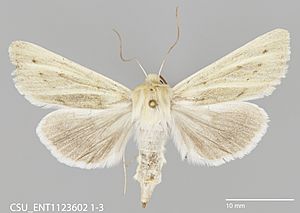Copablepharon viridisparsa
Quick facts for kids Copablepharon viridisparsa |
|
|---|---|
 |
|
| Copablepharon viridisparsa gilvum | |
| Scientific classification | |
| Kingdom: | |
| Phylum: | |
| Class: | |
| Order: | |
| Family: | |
| Genus: |
Copablepharon
|
| Species: |
C. viridisparsa
|
| Binomial name | |
| Copablepharon viridisparsa Dod, 1916
|
|
| Synonyms | |
|
|
The Copablepharon viridisparsa is a type of moth. It belongs to a group of moths called Noctuidae, which are often known as owlet moths. This specific moth was first officially described by a scientist named F. H. Wolley Dod in 1916.
Contents
Where This Moth Lives
This moth can be found in many parts of North America. It lives in southern California and southern Utah. You can also find it further north in southern British Columbia, central Saskatchewan, and southwestern Manitoba in Canada.
Size and Appearance
The Copablepharon viridisparsa moth has a wingspan of about 38 to 42 millimeters. This means that when its wings are fully spread out, they measure between 3.8 and 4.2 centimeters across. That's roughly the length of a large paperclip!
Adult moths usually fly around during the summer months. You can spot them from June to August, but the exact time depends on where they live.
Life Cycle of the Moth
The life of the Copablepharon viridisparsa moth is quite interesting. It goes through several stages, just like many other insects.
Eggs and Young Caterpillars
When adult female moths emerge from their cocoons, their eggs are almost ready. They lay these tiny eggs in loose soil within a week or two. The eggs are laid in the middle of summer.
After the eggs hatch, tiny caterpillars appear. These young caterpillars spend the winter partly grown. They then finish growing and developing the following spring.
Caterpillar Habits
These caterpillars are very quick! If they are uncovered, they can bury themselves into the soil very rapidly to hide. They are mostly active at night. They come out from the soil to feed on plants above ground. During the day, they bury themselves about 2.5 centimeters deep in the soil. They usually hide right under the plants they eat to stay safe.
Becoming a Pupa
When a caterpillar is fully grown, it gets ready for its next big change. It digs into the soil and forms a special earthen cell. This cell is usually about 5 centimeters deep in the ground. Inside this cell, the caterpillar changes into a pupa. The pupa is a resting stage where the moth transforms.
Emerging as an Adult Moth
After about three to four weeks, the amazing transformation is complete. A new adult moth emerges from the pupa. It then digs its way out of the soil, ready to fly and start the life cycle all over again.
Subspecies of Copablepharon viridisparsa
Did you know that there are different types, or subspecies, of this moth? They are all very similar but have slight differences. Here are some of them:
- Copablepharon viridisparsa viridisparsa Dod, 1916
- Copablepharon viridisparsa hopfingeri (Franclemont, 1954)
- Copablepharon viridisparsa gilvum Crabo & Lafontaine, 2004
- Copablepharon viridisparsa ravum Crabo & Lafontaine, 2004

